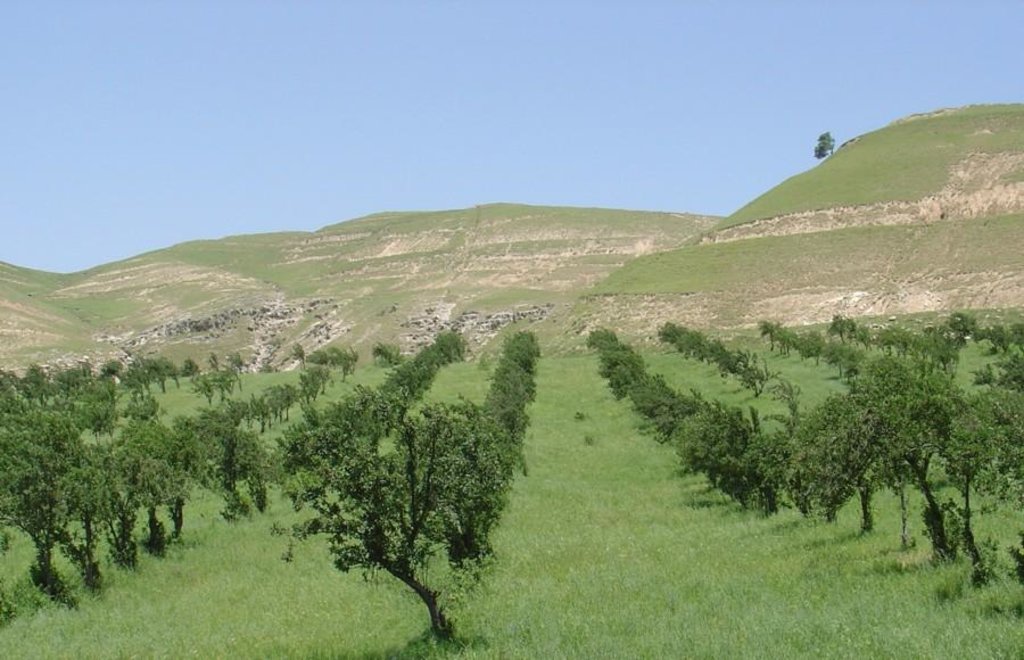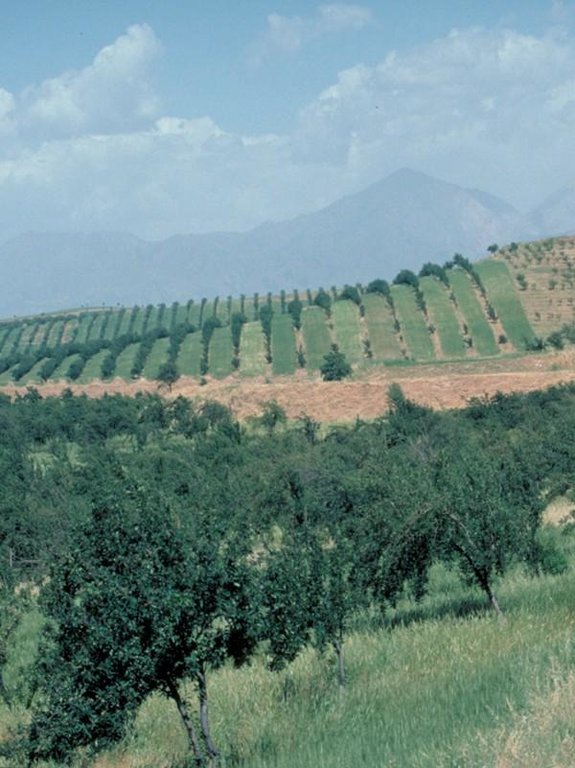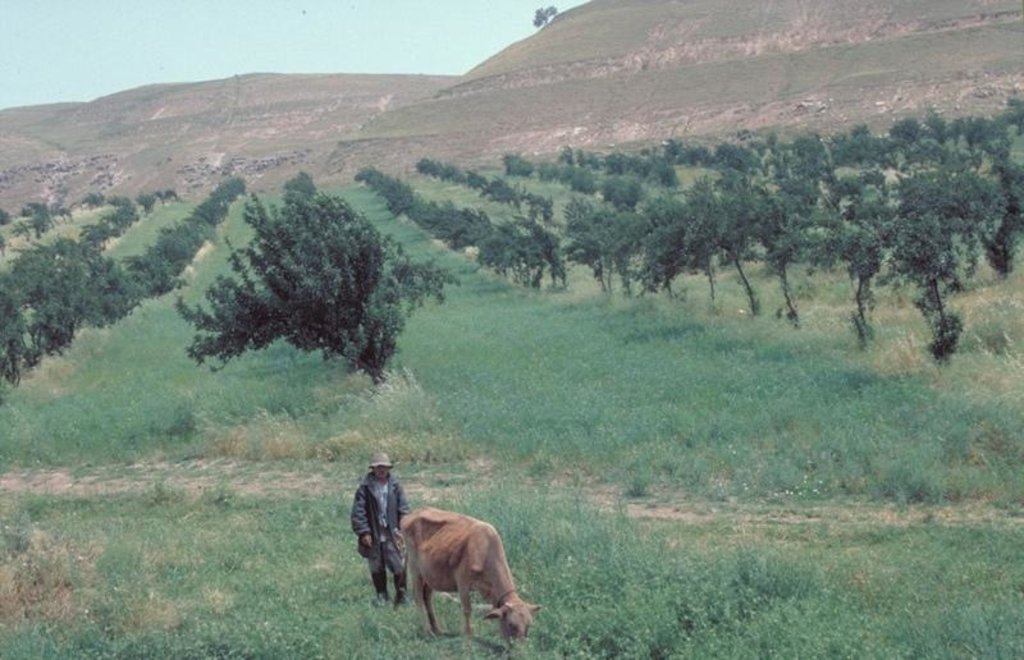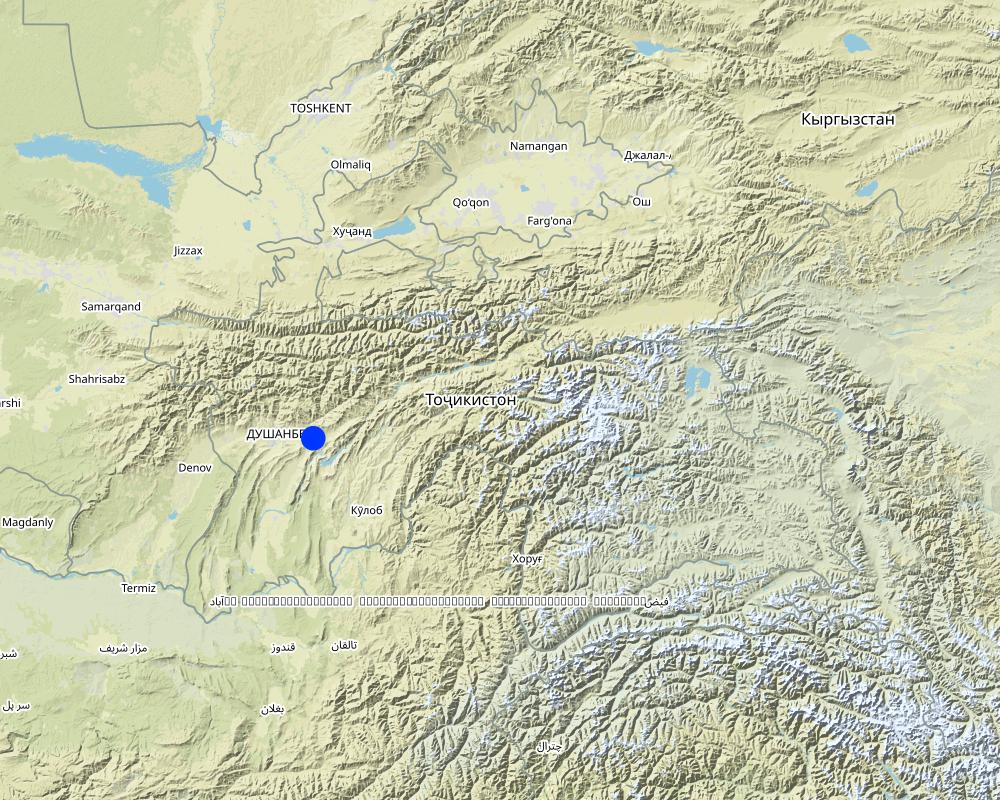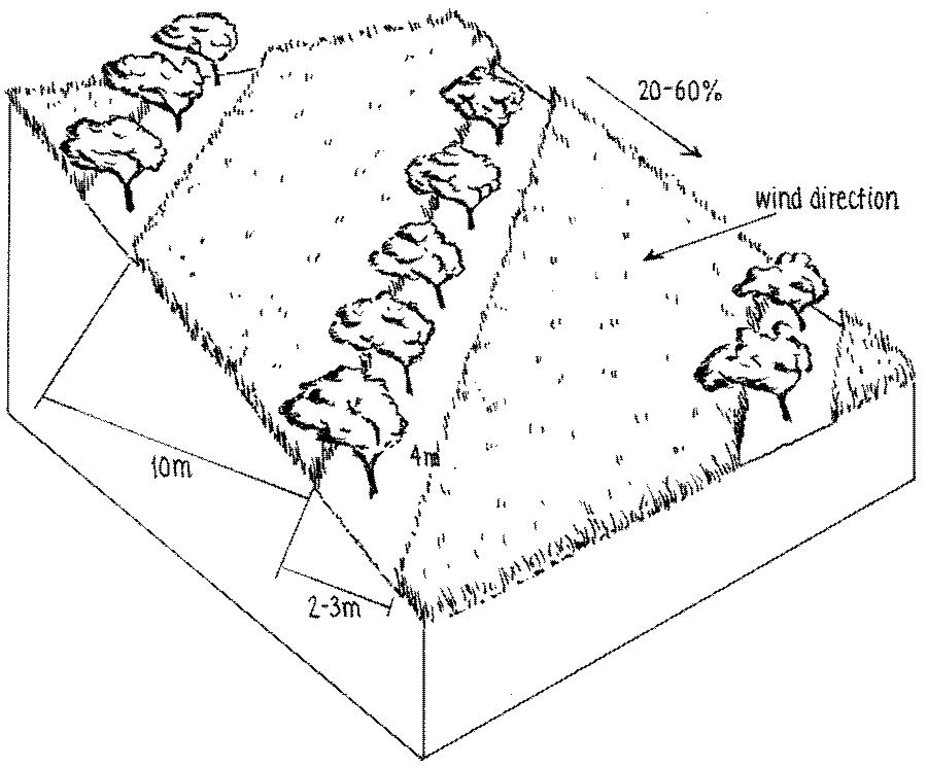Orchard-based agroforestry [塔吉克斯坦]
- 创建:
- 更新:
- 编制者: Loes Masselink
- 编辑者: –
- 审查者: Deborah Niggli, Alexandra Gavilano, David Streiff, Lisa Soloveva, Olga Andreeva, Laura Ebneter, Joana Eichenberger
technologies_1017 - 塔吉克斯坦
- Orchard-based agroforestry: Aug. 14, 2019 (inactive)
- Orchard-based agroforestry: Nov. 2, 2021 (public)
- Orchard-based agroforestry: April 4, 2018 (inactive)
- Orchard-based agroforestry: July 19, 2017 (inactive)
- Orchard-based agroforestry: July 17, 2017 (inactive)
- Orchard-based agroforestry: July 17, 2017 (inactive)
- Orchard-based agroforestry: July 17, 2017 (inactive)
- Orchard-based agroforestry: March 9, 2017 (inactive)
查看章节
全部展开 全部收起1. 一般信息
1.2 参与该技术评估和文件编制的资源人员和机构的联系方式
SLM专业人员:
有助于对技术进行记录/评估的项目名称(如相关)
Book project: where the land is greener - Case Studies and Analysis of Soil and Water Conservation Initiatives Worldwide (where the land is greener)有助于对技术进行记录/评估的项目名称(如相关)
Pilot Program for Climate Resilience, Tajikistan (WB / PPCR)有助于对技术进行记录/评估的机构名称(如相关)
CDE Centre for Development and Environment (CDE Centre for Development and Environment) - 瑞士有助于对技术进行记录/评估的机构名称(如相关)
Soil Science Institute (Soil Science Institute) - 塔吉克斯坦1.3 关于使用通过WOCAT记录的数据的条件
编制者和关键资源人员接受有关使用通过WOCAT记录数据的条件。:
是
1.5 参考关于SLM方法(使用WOCAT记录的SLM方法)的调查问卷
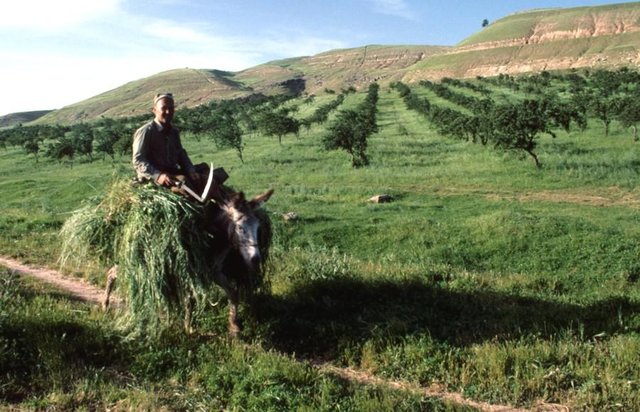
Transition from a centralised regime to a local … [塔吉克斯坦]
A land use system established during the previous authoritarian regime of the Soviet Union is now being adapted to the farmers' needs via their own initiative.
- 编制者: Sanginboy Sanginov
2. SLM技术的说明
2.1 技术简介
技术定义:
An agroforestry system where legumes and cereals are planted in fruit orchards, giving simultaneous production and conservation benefits.
2.2 技术的详细说明
说明:
In the Faizabad region, Tajikistan, an area which is characterised by hilly topography, and deep but highly erodible loess soils, farmers traditionally cultivate beans and wheat in combination with fruit trees. This was a rather unsystematic agroforestry system, and during Soviet times (in the 1980s) fruit production was intensified. Pure-stand orchards were established: the land was levelled and on slopes exceeding 20%, terraces were constructed mechanically. The density of trees was increased, and the little space remaining between was used for hay production. Annual cropping was stopped.
Purpose of the Technology: After the Soviet era, farmers reduced the number of trees, allowing room for inter-cropping. They also established new orchards according to this same pattern. Those who farm rented land merely inter crop wheat, whereas the few farmers who own their land, rotate crops with two years of wheat, followed by one of legumes (beans or lucern). Crops are grown both for home consumption and sale.
Establishment / maintenance activities and inputs: The density of apples was reduced by expanding the spacing from approx 5 m to 10 m between rows, and from 2 m to 4 m within rows. Along each row of trees a 2-3 m strip of grass was left to grow. The layout of fruit trees in lines is a compromise between being along the contour, and against the prevailing wind. After harvesting of the fruit, between August and October, farmers sow their annual crops.
Natural / human environment: This agroforestry system provides protection against strong winds, heavy rains and flooding. Soil erosion (by water) has been reduced due to improved soil cover by the inter cropping, and through leaf litter, which is left to decompose on the ground. Furthermore, after harvesting, about three quarters of the crop residues are left on the field as mulch. The remainder is used as fodder. Soil organic matter within the current agroforestry system is considerably higher than in the surrounding grazing areas. Soil fertility has improved also: beans can fix 60-80 kg/ha/year of nitrogen. Compared with other crops, wheat provides the best erosion protection. Since the lateral rooting system of the apple trees reaches only 1-1.5 m from the trunk, competition for nutrients is not a major problem. Neither is there a problem with shade, since during the crop establishment period the trees have lose their leaves. In order to increase production, farmers plan to apply supplementary irrigation where possible.
2.3 技术照片
2.5 已应用该技术的、本评估所涵盖的国家/地区/地点
国家:
塔吉克斯坦
区域/州/省:
Tajikistan, Faizabad
有关地点的进一步说明:
Faizabad
注释:
Total area covered by the SLM Technology is 45 km2.
Map
×2.6 实施日期
如果不知道确切的年份,请说明大概的日期:
- 10-50年前
2.7 技术介绍
详细说明该技术是如何引入的:
- 通过土地使用者的创新
3. SLM技术的分类
3.1 该技术的主要目的
- 减少、预防、恢复土地退化
3.2 应用该技术的当前土地利用类型
同一土地单元内混合使用的土地::
是
具体说明混合土地使用(作物/放牧/树木):
- 农林业

农田
- 一年一作
- 乔木与灌木的种植
年作 - 具体指明作物:
- 豆科牧草和豆类 - 豆子
- 谷类 - 小麦(春季)
- lucerne
乔木和灌木种植 - 指定作物:
- 仁果类(苹果、梨子、柑橘等)
注释:
Major land use problems (compiler’s opinion): Most of the rains fall in late autumn and early spring, and the rains coincide with very strong winds. The topsoil is therefore exposed to erosion during this period if left uncovered, and without a windbreak. A particular problem during the soviet period was that the intensive orchard system meant annual food crops were left out of the production system: soil cover was reduced and there was less food.
Type of cropping system and major crops comments: two years of wheat followed by one of legumes (beans or lucerne)
3.4 供水
该技术所应用土地的供水:
- 雨养
3.5 该技术所属的SLM组
- 农业林学
- 防风林/防护林带
- 改良的地面/植被覆盖
3.6 包含该技术的可持续土地管理措施

农艺措施
- A2:有机质/土壤肥力
- A7:其它

植物措施
- V1:乔木和灌木覆盖层
- V2:草和多年生草本植物

结构措施
- S1:阶地
注释:
Main measures: agronomic measures, vegetative measures, structural measures
Type of agronomic measures: mulching, rotations / fallows
Type of vegetative measures: aligned: -against wind
3.7 该技术强调的主要土地退化类型

土壤水蚀
- Wt:表土流失/地表侵蚀
- Wg:冲沟侵蚀/沟蚀

土壤风蚀
- Et:表土流失

化学性土壤退化
- Cn:肥力下降和有机质含量下降(非侵蚀所致)
注释:
Main type of degradation addressed: Wt: loss of topsoil / surface erosion, Wg: gully erosion / gullying, Et: loss of topsoil, Cn: fertility decline and reduced organic matter content
Main causes of degradation: other human induced causes (specify) (The suplementary irrigation system could not be maintained after state farms stopped recieving government support. Thus, it became more interesting to increase crop production through intercropping.)
Secondary causes of degradation: governance / institutional (With the transformation of the planned economy to a market economy, for the state farm areas new forms of management had to be found.)
3.8 防止、减少或恢复土地退化
具体数量名该技术与土地退化有关的目标:
- 防止土地退化
注释:
Main goals: prevention of land degradation
4. 技术规范、实施活动、投入和成本
4.1 该技术的技术图纸
技术规范(与技术图纸相关):
Fruit trees intercropped with wheat (or beans): note the fruit trees are aligned in a 'compromise' position between the direction of the prevailing wind and the slope.
Location: Faizabad. Faizabad, Tajikistan
Date: 25-07-2004
Technical knowledge required for field staff / advisors: moderate
Technical knowledge required for land users: moderate
Main technical functions: improvement of ground cover, increase in nutrient availability (supply, recycling,…), reduction in wind speed, improvement of soil fertility (with crop rotation incl. Beans+lucerne)
Secondary technical functions: control of concentrated runoff: retain / trap, reduction of slope angle, improvement of subsoil structure (hardpan), water harvesting / increase water supply, retain/trap concentrated runoff (prevention of gully erosion)
Mulching
Material/ species: leaf litter, crop residues
Rotations / fallows
Material/ species: wheat, legumes
Aligned: -against wind
Vegetative material: T : trees / shrubs, G : grass
Vertical interval between rows / strips / blocks (m): 2-6
Spacing between rows / strips / blocks (m): 10
Vertical interval within rows / strips / blocks (m): 4
Width within rows / strips / blocks (m): 2-3
Slope (which determines the spacing indicated above): 20-60%
terrace: forward sloping: earth
作者:
Mats Gurtner, Centre for Development and Environment (CDE), University of Bern
4.2 有关投入和成本计算的一般信息
具体说明成本计算所用货币:
- 美元
4.3 技术建立活动
| 活动 | 时间(季度) | |
|---|---|---|
| 1. | Planting of fruit orchard | |
| 2. | Thinning: doubling the spacing between trees (by farmers, after Soviet period) | |
| 3. | Hand planting of fruit tree seedlings | |
| 4. | planting fruit trees | |
| 5. | 1. Levelling of steep land into terraces with graders | |
| 6. | Planting of fruit orchards |
4.4 技术建立所需要的费用和投入
| 对投入进行具体说明 | 单位 | 数量 | 单位成本 | 每项投入的总成本 | 土地使用者承担的成本% | |
|---|---|---|---|---|---|---|
| 劳动力 | Planting of fruit orchard | ha | 1.0 | 60.0 | 60.0 | 100.0 |
| 劳动力 | Thinning and hand lanting | ha | 2.0 | 10.0 | 20.0 | 100.0 |
| 设备 | machine use | ha | 1.0 | 120.0 | 120.0 | 100.0 |
| 设备 | tools | 1.0 | 10.0 | 10.0 | 100.0 | |
| 植物材料 | seedlings | ha | 1.0 | 250.0 | 250.0 | |
| 肥料和杀菌剂 | fertilizer | ha | 1.0 | 50.0 | 50.0 | 100.0 |
| 肥料和杀菌剂 | biocides | ha | 1.0 | 30.0 | 30.0 | 100.0 |
| 肥料和杀菌剂 | pesticides | ha | 1.0 | 30.0 | 30.0 | 100.0 |
| 技术建立所需总成本 | 570.0 | |||||
| 技术建立总成本,美元 | 570.0 | |||||
4.5 维护/经常性活动
| 活动 | 时间/频率 | |
|---|---|---|
| 1. | Applying organic manure for crops and trees | (November to March) |
| 2. | Ploughing to depth of 25–30 cm for annual crops | (November to March) |
| 3. | Disc ploughing and harrowing . | (March) |
| 4. | Chemical fertiliser application to crops | (once during season). |
| 5. | Pest management with chemicals | (two-three times where possible/affordable) |
| 6. | harvesting: wheat is the only crop, which can be harverted if tractor and petrol is available | |
| 7. | mulching trees (humus cover) | |
| 8. | cutting trees |
4.6 维护/经常性活动所需要的费用和投入(每年)
| 对投入进行具体说明 | 单位 | 数量 | 单位成本 | 每项投入的总成本 | 土地使用者承担的成本% | |
|---|---|---|---|---|---|---|
| 劳动力 | applying organic manure for crops and trees | ha | 1.0 | 45.0 | 45.0 | 100.0 |
| 劳动力 | ploughing | ha | 2.0 | 10.0 | 20.0 | 100.0 |
| 设备 | labour animal traction | ha | 1.0 | 10.0 | 10.0 | 100.0 |
| 设备 | labour harvesting | ha | 1.0 | 100.0 | ||
| 设备 | labour mulching and cutting | ha | 1.0 | 50.0 | 50.0 | 100.0 |
| 植物材料 | seeds | ha | 1.0 | 30.0 | 30.0 | 100.0 |
| 肥料和杀菌剂 | fertilizer | ha | 1.0 | 50.0 | 50.0 | 100.0 |
| 肥料和杀菌剂 | biocides | ha | 1.0 | 5.0 | 5.0 | 100.0 |
| 肥料和杀菌剂 | compost manure | ha | 1.0 | 10.0 | 10.0 | 100.0 |
| 技术维护所需总成本 | 220.0 | |||||
| 技术维护总成本,美元 | 220.0 | |||||
注释:
Cost calculation refers to farmers who established new agroforestry plots (without receiving any incentives). These are farmers who have rented land from state farms. However, conversion of Soviet orchards is more common than the establishment of new agroforestry plots (information on costs not available).
5. 自然和人文环境
5.1 气候
年降雨量
- < 250毫米
- 251-500毫米
- 501-750毫米
- 751-1,000毫米
- 1,001-1,500毫米
- 1,501-2,000毫米
- 2,001-3,000毫米
- 3,001-4,000毫米
- > 4,000毫米
农业气候带
- 半干旱
Thermal climate class: temperate
5.2 地形
平均坡度:
- 水平(0-2%)
- 缓降(3-5%)
- 平缓(6-10%)
- 滚坡(11-15%)
- 崎岖(16-30%)
- 陡峭(31-60%)
- 非常陡峭(>60%)
地形:
- 高原/平原
- 山脊
- 山坡
- 山地斜坡
- 麓坡
- 谷底
垂直分布带:
- 0-100 m a.s.l.
- 101-500 m a.s.l.
- 501-1,000 m a.s.l.
- 1,001-1,500 m a.s.l.
- 1,501-2,000 m a.s.l.
- 2,001-2,500 m a.s.l.
- 2,501-3,000 m a.s.l.
- 3,001-4,000 m a.s.l.
- > 4,000 m a.s.l.
说明该技术是否专门应用于:
- 不相关
关于地形的注释和进一步规范:
Landforms also mountain slopes.
5.3 土壤
平均土层深度:
- 非常浅(0-20厘米)
- 浅(21-50厘米)
- 中等深度(51-80厘米)
- 深(81-120厘米)
- 非常深(> 120厘米)
土壤质地(表土):
- 中粒(壤土、粉土)
表土有机质:
- 低(<1%)
如有可能,附上完整的土壤描述或具体说明可用的信息,例如土壤类型、土壤酸碱度、阳离子交换能力、氮、盐度等。:
Soil fertility: low
Soil drainage / infiltration: good
Soil water storage capacity: medium
5.4 水资源可用性和质量
地下水位表:
< 5米
地表水的可用性:
匮乏/没有
水质(未处理):
良好饮用水
5.5 生物多样性
物种多样性:
- 高
5.6 应用该技术的土地使用者的特征
生产系统的市场定位:
- 混合(生计/商业)
非农收入:
- > 收入的50%
机械化水平:
- 手工作业
- 机械化/电动
说明土地使用者的其他有关特征:
Off-farm income specification: trade and business; young men often migrate to Russia (seasonally or for several years) to search for jobs
Level of mechanization manual work: pruning of trees, harvesting, applying herbizids
Level of mechanization animal traction: ploughing if no fuel for tractors is available
Level of mechanization mechanized/motorized: Disc ploughing and harrowing, if petrol is available
5.7 应用该技术的土地使用者使用的平均土地面积
- < 0.5 公顷
- 0.5-1 公顷
- 1-2 公顷
- 2-5公顷
- 5-15公顷
- 15-50公顷
- 50-100公顷
- 100-500公顷
- 500-1,000公顷
- 1,000-10,000公顷
- > 10,000公顷
这被认为是小规模、中规模还是大规模的(参照当地实际情况)?:
- 小规模的
注释:
Average area of land owned or leased by land users applying the Technology also 2-5 ha
5.8 土地所有权、土地使用权和水使用权
土地所有权:
- 州
土地使用权:
- 租赁
5.9 进入服务和基础设施的通道
健康:
- 贫瘠
- 适度的
- 好
教育:
- 贫瘠
- 适度的
- 好
技术援助:
- 贫瘠
- 适度的
- 好
能源:
- 贫瘠
- 适度的
- 好
道路和交通:
- 贫瘠
- 适度的
- 好
6. 影响和结论性说明
6.1 该技术的现场影响
社会经济效应
生产
作物生产
饲料生产
木材生产
收入和成本
农业收入
其它社会经济效应
trees hinder farm operations
注释/具体说明:
difficult to apply pesticides using machinery and pesticides are very expensive.
Pruning is important, but farmers are new to the system and don’t always have the skills required
社会文化影响
社区机构
冲突缓解
生态影响
水循环/径流
多余水的排放
土壤
土壤水分
土壤覆盖层
土壤流失
土壤有机物/地下C
减少气候和灾害风险
风速
其它生态影响
nutrient use efficiency
water use efficiency
soil fertility
注释/具体说明:
Also biodiversity enhancement is medium (20-50%)
6.2 该技术的场外影响已经显现
旱季稳定可靠的水流
下游洪水
下游淤积
地下水/河流污染
风力搬运沉积物
6.4 成本效益分析
技术收益与技术建立成本相比如何(从土地使用者的角度看)?
短期回报:
积极
长期回报:
非常积极
技术收益与技术维护成本/经常性成本相比如何(从土地使用者的角度看)?
短期回报:
非常积极
长期回报:
非常积极
6.5 技术采用
- 11-50%
如若可行,进行量化(住户数量和/或覆盖面积):
3500 land user families have adopted the Technology without any external material support in an area of 45 km^2
在所有采用这项技术的人当中,有多少人是自发的,即未获得任何物质奖励/付款?:
- 91-100%
注释:
3500 land user families have adopted the Technology without any external material support
There is a strong trend towards spontaneous adoption of the Technology
Comments on adoption trend: Adoption rate is high: 3,500 households in the region, who rented the orchards, have converted them themselvs without any incentives.
6.7 该技术的优点/长处/机会
| 编制者或其他关键资源人员认为的长处/优势/机会 |
|---|
|
Easy to convert orchards How can they be sustained / enhanced? Land reform from state to private ownership would assist the process and strengthen farmers' associations. |
| Helps provide employment (mainly self- employment, partial employment of additional labourers) and increased self-sufficiency. With the cultivation of wheat, some farmers can solve their food problems and do not need an off-farm income. |
|
Improvement of soil fertility and soil organic matter content How can they be sustained / enhanced? Use all the crop residue and leaves of trees as cover (mulch). |
|
Considerable reduction of soil erosion How can they be sustained / enhanced? Adopt cover crop and rotate with other legumes and minimum tillage system. |
|
Wider spacing between the rows of trees (to 10 m) is best for the agroforestry How can they be sustained / enhanced? Remaining orchards with the original Soviet spacing of 5m between the rows should be thinned. |
6.8 技术的弱点/缺点/风险及其克服方法
| 编制者或其他关键资源人员认为的弱点/缺点/风险 | 如何克服它们? |
|---|---|
| The irrigation system established during Soviet times required high maintenance inputs due to siltation of the canals. During the period of the civil war systems ceased to function, the canals filled up with sediments and finally overflowed during rain storms causing gully formation | Control of water flow within the orchard using cutoff drains and drainage ditches. |
| Lines of trees which are planted up and down the slope to provide wind. | Compromise in layout design (see description). |
| Orchards managed by state farms are often not well looked after. | Leasing of land and awarding landholder certificates leads to improved orchard management. |
7. 参考和链接
7.1 信息的方法/来源
7.3 链接到网络上的相关信息
标题/说明:
Loes Masselink. 2012. Monitoring SLM Practices in Tajikistan. BSc thesis, Land Degradation and Development Group, International Land and Water Management at Wageningen University. The Netherlands.
URL:
https://www.wocat.net/fileadmin/user_upload/documents/Theses/Masselink2012.pdf
链接和模块
全部展开 全部收起链接

Transition from a centralised regime to a local … [塔吉克斯坦]
A land use system established during the previous authoritarian regime of the Soviet Union is now being adapted to the farmers' needs via their own initiative.
- 编制者: Sanginboy Sanginov
模块
无模块



